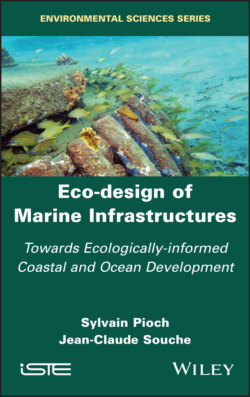Читать книгу Eco-design of Marine Infrastructures - Sylvain Pioch - Страница 20
1.4. Assessing the effects of a project on the environment: the impact study
ОглавлениеAs we briefly recalled at the beginning of this book, humanity’s priority is to deal with the artificialization of natural environments, which is dramatic for biodiversity, particularly in marine and coastal environments. Among the tools available to planners who are aware of this global problem, the environmental impact assessment (EIA) of projects has been widely used since the 1970s (Bonneuil 2004). This tool is inspired by work in ecology intended to organize the comparison of the spatio-temporal effects of a human action on a natural environment (before/after an impact), formalized by the Before-After Control-Impact (BACI) approach (Green 1979).
The EIA is thought of as a regulation of unreasonable artificialization and as a tool for social acceptability; it is integrated by the state, planners and civil society (Gobert 2010). In its most modern form, particularly in France, it is based on three hierarchical sequences for mitigation in the analysis of the environmental impacts of a project, symbolized by the acronym ARO for “avoid, reduce, offset”, and applied in a manner proportionate to the issues at stake in a project.
The pivotal consideration of the impact assessment, whether or not it leads to development authorization, and thus to construction choices, clearly rests on this sequence, where offset is supposed to negate the notable and residual negative impacts of a project (Pioch et al. 2015).
Assessing impacts is not straightforward. This is what road ecology deals with, for example, in an attempt to quantify the impacts (positive or negative) of linear infrastructures on the environment in general, and more specifically on biodiversity, with effects of habitat destruction or fragmentation (Clevenot et al. 2017). Part of the research is devoted to mitigating and offsetting for negative impacts. The aim is to make infrastructures “transparent” to the landscape and its ecological function (Rytwinski et al. 2016).
Thus, over the past 50 years, planners have had to develop new approaches to meet this requirement to avoid, reduce as much as possible (or at least below a “significant” threshold) and finally offset the inevitable or irreducible residual impacts of any project. However, even though the regulations seem to be robust, if we look at the results in France, let us be clear, the record has been catastrophic since the introduction of the EIA in 1976 (Act no. 76-629 of July 10, 1976). According to Bigard et al. (2017), more than 77% of the definitions of ARO measures proposed in a sample of 42 terrestrial EIA files are wrong. At sea, Jacob et al. (2016) demonstrated, based on the study of 55 EIA files between 2000 and 2015 (France and DOM-TOM18), that 85% conclude that there is no significant residual negative impact of infrastructures on biodiversity. Furthermore, in the 15% of projects identifying the need for compensatory measures to repair biophysical losses, these are not actually implemented in the field (less than 10% of cases). These data and observations lead us to take a critical look at our own development (or “non-development”) choices.
The fundamental objectives of the EIA are recalled in Article L. 122-1 of the Environmental Code, requiring that “the studies prior to the realization of developments or works which, through the importance of their dimensions or their impact on the natural environment, may affect the latter, must include an impact study to assess the consequences”.
The impact study is an essential step in the environmental assessment of development projects and works. It is an approach designed to:
– integrate environmental concerns into the design of a project by its promoter;
– inform the authority called upon to decide whether to authorize its implementation;
– inform the public by involving them in the decision-making process.
